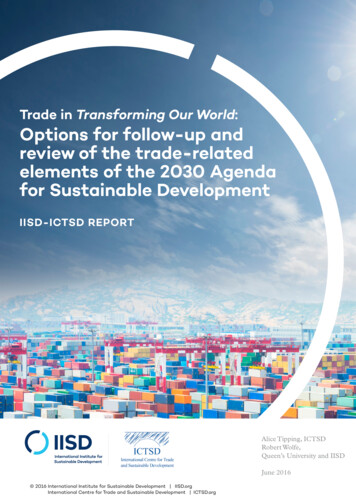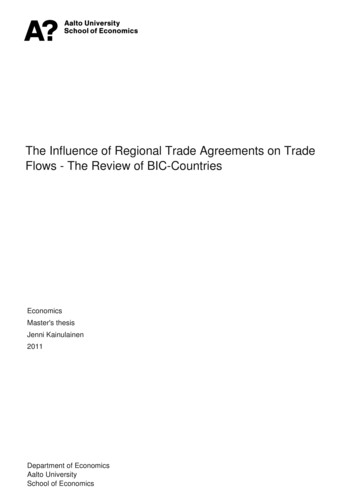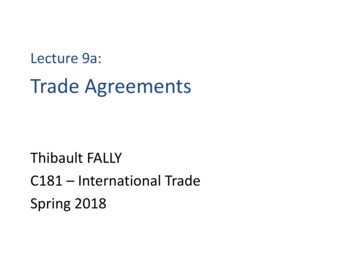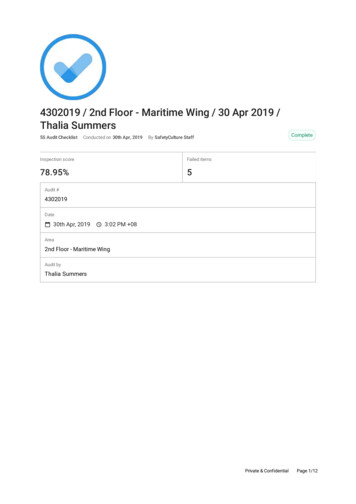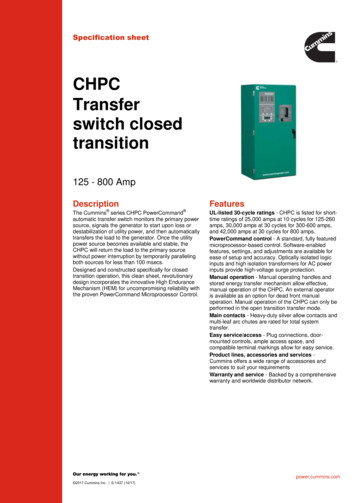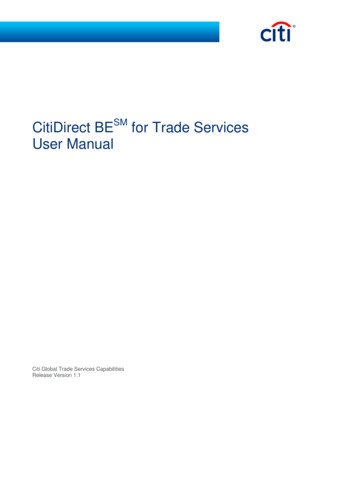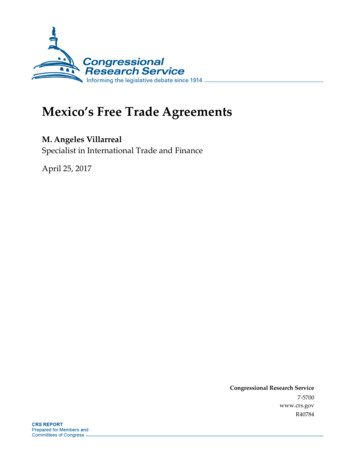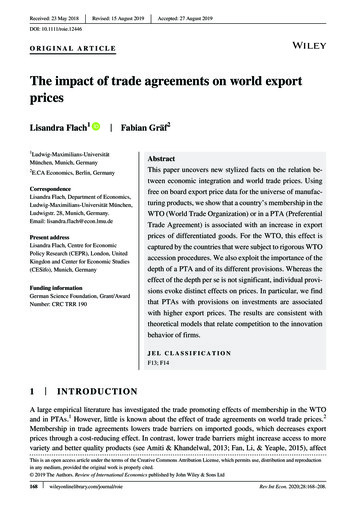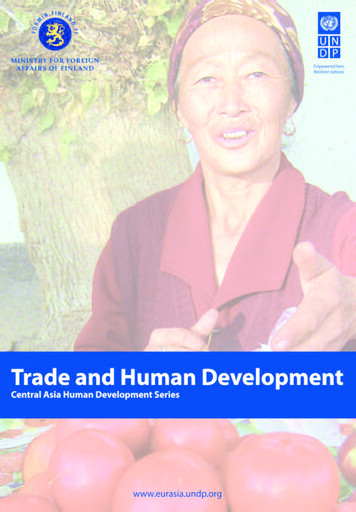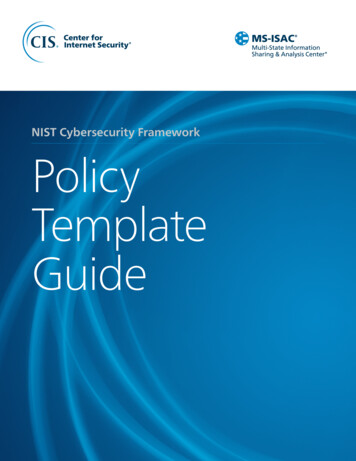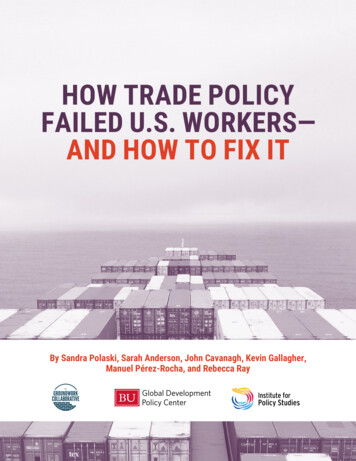
Transcription
HOW TRADE POLICYFAILED U.S. WORKERS—AND HOW TO FIX ITBy Sandra Polaski, Sarah Anderson, John Cavanagh, Kevin Gallagher,Manuel Pérez-Rocha, and Rebecca RayHOW TRADE POLICY FAILED U.S. WORKERS—AND HOW TO FIX IT1
CONTENTSContents 2Executive Summary 3Key priorities 4Introduction 6A trade policy that went wrong 8Trump’s hostile approach to China has not helped U.S.workers and communities 23A new trade policy that supports recovery fromthe pandemic, creates jobs and helps to build a fairand sustainable future economy 27Conclusion 49About the Authors and Acknowledgements 50Endnotes 52 2020 by the Institute for Policy Studies, Boston University Global Development Policy Center, andGroundwork Collaborative. This is an Open Access article, distributed under the terms of the Creative CommonsAttribution license (http://creativecommons.org/licenses/by/4.0/), which permits unrestricted reuse, distribution,and reproduction in any medium, provided the original work is properly cited.2
EXECUTIVE SUMMARYOver the last several decades, U.S. tradepolicies have failed most Americans.Under the guise of “free trade” specialinterests have captured trade policy toextract wealth at home and abroad andleave working people to bear the costs.Coupled with the myriad of domesticpolicy failures that have left workers,families and communities worse off,U.S. trade policy made Americans morevulnerable to the COVID-19 crisis, interms of both their jobs and their health.Despite the U.S. having the world’s largesteconomy, many households are strugglingto survive. Its hollowed-out manufacturingsector cannot produce the essential virusprotection equipment and components thatU.S. workers and households desperatelyneed. The combined impacts of failedtrade policy and the botched handlingof the pandemic have also compoundedinequality, with women, Blacks and othercommunities of color disproportionatelysuffering the loss of jobs.In 2016 Donald Trump campaigned ona promise to change the course of U.S.trade policy. But his counterproductivetariff wars have made things worse. Evenbefore the pandemic, former manufacturingcenters of the Midwest were experiencingslower job growth under Trump than underthe Obama administration. His signatureinitiatives — the renegotiation of the NorthAmerican Free Trade Agreement (NAFTA)and his trade war with China — have failedto produce good jobs. The official U.S.government projection of the impact ofthe revised NAFTA (now called the USMexico-Canada Agreement or USMCA)projects a loss to the U.S. economy andfewer jobs as a result of the agreement,unless one accepts dubious propositionsabout the value of its pro-corporatederegulatory measures. The trade war withChina led to higher costs for consumersand losses to farmers cut off from that keymarket. For manufacturing sectors, anypositive effects from Trump’s tariffs weremore than offset by the rising cost of inputsand negative effects from retaliatory tariffsimposed by trading partner countries whofight tit-for-tat when targeted. The onlywinners of the Trump trade policy? Bigpharma, big finance and big tech.To distract Americans from his failedpolicies and failed handling of the currenteconomic and health disaster, PresidentTrump blames China—for everything.And yet despite his anti-China rhetoric,foreign direct investment by U.S.corporations into China has continued athigh levels throughout his presidency. In2019, for example, U.S. firms invested 14.13 billion in China—more than in2016, the year he was elected—led byconstruction of new auto plants there byTesla and General Motors. The fact is thatChina continues to invest in infrastructureand manufacturing and as a result attractsinvestment from across the world.Meanwhile Trump showered tax breaks onthe rich instead of investing in America’sjobs and crumbling infrastructure.HOW TRADE POLICY FAILED U.S. WORKERS—AND HOW TO FIX IT3
Judging by the trade deficit—the measureof U.S. trade performance preferred byTrump—he has clearly failed. There hasbeen a larger trade deficit in each of thethree full years of his presidency than therewas when he took office from Obama.In this time of crisis, we need a newtrade policy more than ever to support aneconomic recovery from the pandemicand to start building an equitable economythat is resilient to future crises. A newpolicy must shift bargaining power awayfrom corporations and towards workingpeople to create an economy that works foreveryone, not just special interests.This new policy should emphasizeinternational cooperation—rather thanantagonistic tariff wars—to encouragepolicies that lift up working familiesaround the world, stabilize the globaleconomy and provide a global order thatprotects public health, addresses climatechange and builds a green economy nowand for future generations.KEY PRIORITIES: n immediate moratorium on all international trade and investment rules that restrictAgovernment responses to the crisis. These include intellectual property rules that limitthe availability and affordability of medicines and medical equipment; rules that allowpenalties against subsidies designed to stimulate domestic production; and rules thatallow foreign investors to sue governments over public interest policies that reducetheir profits. enegotiation of all trade rules that constrain pro-worker and pro-environmentRdomestic policy agendas. A recovery from the pandemic-induced economic collapsewill require significant support from the government for job creation, health and socialservices, new infrastructure and the green industries of the future. Many current traderules—often negotiated at the insistence of pro-corporate U.S. negotiators—forbidsubsidies and industrial policies. These need to be suspended and then renegotiatedto allow the U.S. and other countries to rebuild their devastated economies. Ifanother country’s economic model leads to negative labor and environmental effectselsewhere, the new rules should allow the U.S. and others to use border measures(tariffs, taxes, denial of entry of products, etc.) to protect their own labor, social andenvironmental objectives. Each country must be free to choose the economic systemand policies that produce the results its people want. trong new enforcement mechanisms to hold individual corporations accountableSfor violations of labor, human, and environmental rights and standards in tradingpartner countries. U.S. trade agreements put the responsibility for protecting theserights and standards on governments. However, it is usually private firms that commitHOW TRADE POLICY FAILED U.S. WORKERS—AND HOW TO FIX IT4
the violations and they, too, must be held accountable for their actions and face realpenalties for failure to respect rights and standards. E limination of monopoly protections for essential medicines and new rules thatencourage innovation and cooperation in the pharmaceutical and medical productindustries. It is critical that we learn from the current crisis to advance rules thatensure rapid deployment of new treatments that are accessible for everyone and lowerprices for U.S. and global consumers. rade rules that provide incentives for goods and services that prevent, mitigate andThelp adapt to climate change. Disincentives such as border taxes should be levied ongoods and services that exacerbate climate change. Adjustment financing for workersand communities currently dependent on fossil fuels should be included in tradedeals. Trade rules should complement domestic agendas for a just transition to a cleanenergy economy that does not leave workers behind. E limination of investor-state dispute settlement. This anti-democratic system allowsprivate foreign corporations and investors to sue governments over public interestlaws and regulations. It also encourages offshoring of U.S. jobs by restricting theability of foreign governments to improve labor and environmental regulations. new mechanism for screening foreign investments to ensure they contribute to realAsecurity. This would go beyond the current screening process focused on “nationalsecurity” issues to ensure foreign investors make concrete commitments to providingdecent jobs and benefits for local workers and communities, particularly vulnerablegroups, in an environmentally sustainable manner. E limination of trade and investment rules that prevent policymakers from controllingfootloose capital. Without a full toolbox of financial tools, governments are limitedin their ability to prevent crises like the 2008 crash and the economic impact of thecurrent pandemic from spreading from one country to another, with devastatingeffects on U.S. jobs and workers’ pension accounts. enegotiation of trade deals to include effective penalties for tax dodging byRmultinational corporations and the wealthy. The U.S. government should work withglobal partners to forge an international agreement to stop the global race to thebottom in corporate taxes and allow countries to raise the revenue needed for recoveryand to finance inclusive societies for the future. verhaul of the current anti-democratic trade policy-making process. CorporateOlobbyists have called the shots on trade policy for too long. A new trade policy mustexpand the power of workers and other public interest stakeholders over decisionmaking and oversight.HOW TRADE POLICY FAILED U.S. WORKERS—AND HOW TO FIX IT5
1. INTRODUCTIONAs COVID-19 spread around the world—upending lives, health care and economieson every continent—the massive faultsof existing systems were laid bare. TheU.S. has fared especially badly and theimmediate requirement is to repair thegaping holes in the public health systemand economic safety net and create jobs toreplace the millions of livelihoods that weredestroyed. But now we must also makepolitical choices and start to rebuild for thefuture. This is the right moment to reflecton the unfettered financial and investmentglobalization that has shaped our livesover recent decades. More recently thatversion of globalization has morphed intoa geopolitical rivalry between the U.S. andChina, threatening to pull the world into anew cold war.AS WE START TO REBUILDWE NEED A COHERENTUNDERSTANDING OF WHY THEU.S. ECONOMY—THE LARGEST INTHE WORLD, WITH ENORMOUSWEALTH—LEFT ITS WORKINGPEOPLE SO VULNERABLE.COVID-19 will bring many changes,but whether the change is for the betteror worse is indeterminate. What we donext will depend on how well we analyzethe causes of the current health andeconomic disaster; whether we correctlyunderstand the roles played by differentpolicies, values and countries; and howhonest we are in setting out alternativesand pursuing those that can create aviable, fair and humane system for thefuture. As we start to rebuild we need acoherent understanding of why the U.S.economy—the largest in the world, withenormous wealth—left its working peopleso vulnerable to such harsh health andeconomic fallout. One important aspectof this analysis, and the purpose of thisreport, is to understand the role of tradeand international economic integration inorder to ensure that trade and investmentrules are aligned with urgent and longerterm needs, rather than standing in theway.The report begins with an examination ofU.S. trade policy before the pandemic andreveals an approach tilted heavily towardthe interests of the financial sector andlarge and concentrated U.S. corporations,with negative impacts on many workersand households. U.S. trade policy createdperverse incentives for U.S. corporationsto move jobs, production and investmentoverseas, where they enjoyed hugeprofits and often avoided taxes. As thesefirms destroyed jobs and pushed downwages and regulations in the U.S., thegovernment failed to change course anddid little to help those who lost from itsunbalanced policies.HOW TRADE POLICY FAILED U.S. WORKERS—AND HOW TO FIX IT6
These failures were a campaign focus ofthen-candidate Donald Trump in 2016, butonce in office he doubled down on the procorporate approach. While throwing onsome tariffs and blaming other countries,the core of his trade policy aims to increaseprofitability and privileges for firms andinvestors. Despite bombastic rhetoric, thedata in the next two sections of this reportshow that he did nothing to improve thequality, security and wages of U.S. jobs.We review his main trade actions andagreements, including his deal to replaceNAFTA and his trade war with China, andexamine their impact on U.S. workers andhard-hit regions. The report then discussesTrump’s overall approach to China andwhat it means for jobs, wages and securityin the U.S. and beyond. We proposeconstructive ways to develop a U.S.China relationship that benefits both of theworld’s two largest economies and thus theworld economy as a whole and avoids therisk of dangerous confrontations or even awar that nobody could win.The report then focuses on the futureand how trade policy should be changedto recover the ground lost over recentdecades and rebuild on a sound basis afterthe pandemic-induced recession. As weface a long and difficult recovery it iscritical that every U.S. public policy mustcontribute to a revival of the economy,with a focus on empowering and liftingworking households out of the recessionand providing the public goods andservices needed for health and social wellbeing. The U.S. should also be a leader inestablishing the minimum rules neededto stabilize the global economy in a waythat allows each country to participate intrade as a component of its own recovery,recognizing that a hostile, us-against-themattitude toward the world jeopardizesour own welfare while increasing thelikelihood of serious conflicts. The reportsketches out a new trade policy built toachieve equitable outcomes within theU.S. and across countries, prioritizingthe interests of labor over investorsand recognizing that labor exploitationanywhere undermines fairness everywhere.Curbing corporate power and shiftingpower to working people is a necessarypart of a strategy to create quality jobs andbroadly rising living standards across theworld, making everyone better off. Theproposed new trade policy also takes intoaccount that we are facing a climate crisisin addition to the health crisis and includessteps toward a cooperative internationalsystem that builds health, stability andresilience across the world—now andsustainably into the future.HOW TRADE POLICY FAILED U.S. WORKERS—AND HOW TO FIX IT7
2. A TRADE POLICY THAT WENT WRONGTrade was not a controversial topic not solong ago. For three decades after WorldWar II trade worked well for the U.S.and for many other countries, governedby the General Agreement on Tariffs andTrade (GATT). That agreement graduallyreduced tariffs over several rounds ofnegotiations while allowing plenty ofroom for each country to pursue its ownnational policy on employment, investmentand other economic matters. During thoseyears increasing U.S. exports translatedinto increased domestic employment andmany import-competing firms becamemore productive. Those workers whowere displaced by imports were able tofind jobs in an economy that was at fullemployment most of the time due toKeynesian demand management policies,massive infrastructure investment andother factors.1 Trade contributed to risingproductivity in both export and importcompeting sectors and thus providedeconomic space for wages to rise, withstrong trade unions then fighting for andwinning increases.THE CHOICE OF TRADEPOLICIES WAS INCREASINGLYDOMINATED BY THE INTERESTSOF THE U.S. FINANCIALSECTOR AND MULTINATIONALCORPORATIONS.However, beginning with the Reaganadministration in the 1980s, U.S. tradepolicy shifted as part of a broader policyshift toward a profit-maximizing versionof capitalism that came to be known asneoliberalism. Instead of the ongoing,gradual reduction of tariffs as under theGATT, trade policy became an instrumentto project specific pro-business policiesand deregulatory measures onto tradingpartner countries.2 The choice of whichpolicies to project was increasinglydominated by the interests of the U.S.financial sector and multinationalcorporations. U.S. trade policies privilegedinvestors and firms through unfetteredcapital mobility and stringent protectionsfor offshore investments, in contrastwith weak protections for labor and theenvironment and failure to enforce eventhose weak measures.3 At a time when theend of the Cold War and integration of theglobal economy brought a surge of lowwage workers into the global labor forceand tilted bargaining power away fromlabor in favor of investors and firms, U.S.trade policy further augmented the rightsand power of capital rather than seekingto rebalance rights and power towardworking people and communities.The positive impact of trade on theproductivity of U.S. workers and domesticfirms that had been seen during earlierdecades ground to a halt after offshoringof production and global supply chainsgained pace.4 As U.S. multinationalsHOW TRADE POLICY FAILED U.S. WORKERS—AND HOW TO FIX IT8
chose to shutter U.S. factories and shiftjobs to countries with cheap labor and laxregulation, the productivity gains wentstraight into corporate profits, not intothe U.S. economy.5 Meanwhile at homethe rights of workers were under assaultboth by increasingly footloose employersand their lobbyists and by Republicanadministrations from Reagan to Trumpthat eroded labor law protections.6 TheObama administration tried to repairsome of the regulatory damage duringits eight-year term. But the Trumpadministration has subsequently rolledback the Obama reforms; acceleratedthe assault on workers’ rights to formunions and bargain collectively; and givenemployers expanded scope to misclassifyworkers in order to pay less, provide fewor no benefits and otherwise violate theirrights.7 The combination of offshoring andchanges in U.S. labor policy that favoremployers over workers has resulted in thestagnation of wages for the last forty yearsand increasingly precarious employmentand livelihoods.These broad declines have had particularlyharsh consequences for workers in somelocal areas and industries. A study thatlooked at the effects of NAFTA bymeasuring each industry’s vulnerabilityto Mexican imports and each locality’sdependence on vulnerable industriesfound that wage growth was dramaticallylower for blue collar workers in the mostaffected industries and localities, withnegative spillover effects on servicesector workers’ wages as well.8 A seminalstudy examining the effects on local labormarkets of China’s growing exports tothe U.S. found strong impacts in thoseareas where industries exposed to foreigncompetition are concentrated and notedthat the effects were long lasting, “withwages and labor-force participation ratesremaining depressed and unemploymentrates remaining elevated for at least afull decade” and with exposed workersexperiencing reduced lifetime income.9Trade shocks increased inequality forworkers, caused severe adverse socialimpacts on many communities and hadharsh impacts on Black and Hispanicworkers (Box 1).HOW TRADE POLICY FAILED U.S. WORKERS—AND HOW TO FIX IT9
TRADE, INEQUALITY AND WORKERS OF COLORTrade shocks and manufacturing declinehave harsh effects on employment andcommunities. Rising import competitionreduces manufacturing employment amongyoung workers of all races, contributingto increases in social consequences suchas male withdrawal from the labor force,premature mortality, a decline in marriageand fertility and a growth in the share ofchildren raised in poverty.10 These effectsare now widely observed in many regionsaffected by trade. Trade shocks andmanufacturing decline increase inequality,including through the impacts on wagesand home values as well as on socialmeasures including death rates and childmortality.11Black workers are highly represented inindustries that have suffered numeroustrade shocks, such as autos and auto parts,tires and pulp and paper mills and theyand their communities have felt the harshimpacts.12 Because of persisting incomegaps along the lines of race and ethnicity,these job losses were often devastating forcommunities of color who tend to haveless of a financial cushion to withstandspells of unemployment. Localitiesthat are both exposed to trade shocksand have high minority populations areparticularly affected, including cities suchas Detroit, Michigan, Gary, Indiana andYoungstown, Ohio and regions such asnorthern Mississippi, western Tennesseeand central Virginia.13 Across all industriesand regions Black women were 27 percentmore likely and Black men were 34percent more likely to have been displacedthrough a plant closing or other permanentlayoff than their white counterparts andthe disparity has been rising in recentdecades.14NAFTA’s impact on U.S. jobs was feltstrongly in areas where the Hispanicpopulation is highest. Fully half of the950,000 NAFTA-related job lossescertified by the Trade AdjustmentAssistance (TAA) program were in the15 states where 85 percent of the U.S.Hispanic population lives.15 Hispanicworkers are disproportionately representedin light manufacturing, including theapparel and textile sector, which wasdoubly hit by NAFTA and China’saccession to the World Trade Organization(WTO) .Today’s jobs have become more unstable,with lower wages and benefits, for manyU.S. workers across all races, includingthrough the use of subcontracting,outsourcing and temporary employment.About ten percent of workers (15.5million) are in nonstandard jobs astheir primary employment.16 These jobstypically pay less, have fewer benefitsand more variable hours than standardjobs. Black and Hispanic workers areoverrepresented in temporary employmentagency work.17 Manufacturing employershave increased their use of subcontractingand temporary employment in recentdecades, leading to a decrease in thesecurity and wages of manufacturing jobswhich for many workers of color had beena path to the middle class.18HOW TRADE POLICY FAILED U.S. WORKERS—AND HOW TO FIX IT10
The accumulation of legitimate grievancescaused by the shift in U.S. trade policywas exploited in 2016 by then-candidateDonald Trump. Although he denouncedthe effects of earlier trade policies, oncein office he has negotiated trade pactsthat continue to favor the financial sector,pharmaceuticals, technology and corporateagriculture and do little or nothing for U.S.jobs and wages. His counterproductivetariff wars have made things worse:even before the pandemic, formermanufacturing centers of the Midwestwere experiencing slower job growthunder Trump than under the Obamaadministration and his mishandling of thepandemic has hit manufacturing hard. Weexamine his biggest trade initiatives—thedeal to replace NAFTA and his tariffwar and subsequent deal with China—toevaluate how his performance in officecompares with his promises to voters. InBoxes 2 and 3 we focus in on the effects intwo states, Michigan and Ohio.EVEN BEFORE THE PANDEMIC, FORMERMANUFACTURING CENTERS OF THE MIDWEST WEREEXPERIENCING SLOWER JOB GROWTH UNDER TRUMPTHAN UNDER OBAMA.HOW TRADE POLICY FAILED U.S. WORKERS—AND HOW TO FIX IT11
USMCA OR NAFTA 2.0During the 2016 campaign Trumpdenounced NAFTA and promised toreplace it with a better deal. However,the new NAFTA, now called the U.S.Mexico-Canada Agreement (USMCA),continues most of the provisions of theold NAFTA and subsequent U.S. tradedeals and provides major new benefitsto corporations. Instead of focusing onsteps to improve jobs and strengthencommunities and the environment acrossall of North America, the deal restricts theright of the three governments—includingthe U.S.—to adopt new regulations thatwould promote and protect public interests.For example, it constrains the ability ofU.S. lawmakers to rein in harmful contenton U.S. tech platforms and creates newprivileges for U.S. tech and platform firmsthat will allow them to further consolidatetheir global market share, profits andpolitical power.19 It creates more favorableterms for financial firms to operate acrossthe continent (and thus increase theirmarket shares and political influence) andconstrains the ability of the governments toplace limits on their expansion. There aresome limited improvements in the pact’senforcement mechanisms regarding laborrights in Mexico, but these are mainly dueto efforts by Democrats in the U.S. Houseof Representatives, discussed below, ratherthan Trump administration efforts.Even seeming improvements are lessso when examined closely. A provisionrequiring that a portion of autos and autoparts be made by workers earning at least 16 per hour in order to qualify for tarifffree access to the U.S. is a case in point.Notably, the pact allows a majority of partsand assembly (55-60 percent) to continueto be produced at extremely low wages,such as the average wage of about 8 perhour for Mexican auto assembly workersand about 4 per hour for workers in autoparts factories, and still be imported intothe U.S. duty-free. The requirement that40-45 percent be made at an average wageof at least 16 per hour is unlikely to haveany impact on the wages of auto workersin the U.S. and Canada, who already earnconsiderably more. Even in the non-unionplants in the U.S. South the average wagein the industry is close to or meets the 16 per hour requirement. Expenditureson research, development, design andinformation technology can be figuredin to meet the wage requirement, furtherdiluting any impact. Those manufacturerswho do not meet the wage requirementwould pay a 2.5 percent tariff, not much ofa deterrent. Many analysts believe that thisprovision will not lead to more well-payingjobs in the U.S. auto industry.20 A numberof Japanese auto corporations have alreadyannounced that they will raise wages inMexico rather than relocate productionplants.21 A noteworthy study projects thatthe effect of USMCA combined withTrump’s tariffs on steel and aluminum,trade war with China and threatened autotariffs on Europe together would lead to366,900 fewer U.S. jobs.22HOW TRADE POLICY FAILED U.S. WORKERS—AND HOW TO FIX IT12
Another improvement in the USMCAthat is less than meets the eye is therestricted scope for the investor-statedispute settlement mechanism (ISDS).In order to harness the votes to ratify thepact, Trump’s negotiators phased out thiswidely criticized mechanism for disputeswith Canada over three years. It requiredthat such disputes with Mexico would haveto go first through domestic courts beforebeing taken to the private internationaltribunals. That said, in the face of the fossilfuel lobbies, Trump agreed to loopholesthat could allow these industries tocontinue using the ISDS.Overall, the official U.S. governmentestimate of the impact of the USMCAon the U.S. economy and employment isnegative, unless one accepts the flawedhypothesis that the benefit to investors ofreducing government’s ability to regulatein the public interest is worth somethingto the economy as a whole. The U.S.International Trade Commission (USITC),the body charged with estimating andtracking the effects of trade on theU.S. economy, projects that once fullyimplemented the agreement will lead toa small contraction of the U.S. economyand a small reduction of total U.S.employment.23 It is only by ascribing valueto USMCA’s pro-corporate deregulatoryprovisions that “deter the imposition offuture obstacles to trade and investment”and “reduce policy uncertainty” forinvestors that the ITC is able to come upwith a miniscule overall positive impacton the U.S. economy of one-third of onepercent of GDP and a one-time increaseof one-eighth of one percent in total jobsafter six years.24 A study of the economicimpact of USMCA published by theInternational Monetary Fund (IMF) comesto a similar conclusion. It estimates thatCanada and Mexico would each have avery slight welfare gain while the U.S.would have a slight loss and that theoverall effects on the three countries’ GDPwould be negligible.25After Trump signed the agreement withCanada and Mexico, the Democrats in theHouse of Representatives rightly foundit wanting and refused to ratify it unlesscertain changes were made. They wereable to achieve some improvements,including the removal of new protectionsfor pharmaceutical firms that Trump’snegotiators had inserted, which would havefurther driven up the cost of prescriptiondrugs in North America. They also wona stronger enforcement mechanism forprotecting workers’ rights in Mexico,discussed in Section 3.HOW TRADE POLICY FAILED U.S. WORKERS—AND HOW TO FIX IT13
JOBS IN MICHIGAN: TRUMP’S 2016 CAMPAIGN PROMISESAND ACTUAL RESULTSCampaigning for the presidency in 2016,Donald Trump promised Michigan voters hewould “Bring your jobs back to America. . .If I’m elected, you won’t lose one plant.”26He further promised, “We’re going to creategreat jobs and we’re going to get the wagesup.”27After nearly four years of his presidencythe reality has been quite different. FiatChrysler closed its Conner Avenueassembly plant in Detroit in 2017; GeneralMotors closed the Warren Transmissionplant, north of Detroit, in 2019; and Fordhas announced plans to close the engineplant in Romeo, Michigan.28 In additionto the loss of auto plants since 2016,investments by auto firms in Michigandeclined by 29 percent over the three fullyears of Trump’s presidency, comparedwith the previous three years under Obama.Such investments in the state totaled 15.8billion from 2014 through the end of 2016,compared with 11.2 billion from January2017 through January 2020.29Figure 1 shows the evolution of overallmanufacturing employment in Michiganfrom 1990 through 2019. From a peakof 888,000 jobs in 1999 during theClinton administration, employmentfell dramatically during the Bushadministration, with the last stages ofNAFTA’s phase-in, the 2001-2002recession, China’s accession to the WTOand the financial crisis of 2007-
Renegotiation of all trade rules that constrain pro-worker and pro-environment domestic policy agendas. A recovery from the pandemic-induced economic collapse will require significant support from the government for job creation, health and social services, new infrastructure and the green indu
